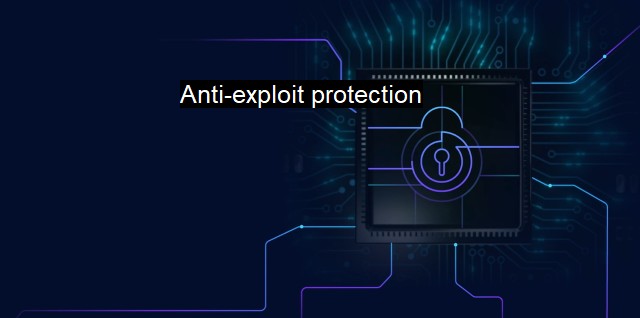What is Anti-exploit protection?
The Importance of Anti-Exploit Protection in Cybersecurity: Techniques, Methods, and Technologies for Preventing Malware Attacks and Securing Networks
In the expanding universe of cybersecurity, methods and approaches develop by leaps and bounds to address new threats and vulnerabilities, often co-aligning with the evolution of technology itself. Anti-exploit protection is one such technology, a significant front-line defense mechanism against cybersecurity threats.In straightforward terms, anti-exploit protection defends against exploitation of software vulnerabilities, which are flaws or weaknesses in a program or system. These vulnerabilities are like open windows in a wall. Where a typical antivirus /anti-malware solution works like a gatekeeper keeping an eye out for malicious intruders, anti-exploit protection ensures that the windows are closed securely so that no attacker can sneak in. it’s a targeted shield that defends certain common areas in the system where intrusion attempts frequently occur, providing a protective cover even before a threat is recognized.
Exploits are packages of code crafted by cybercriminals for extracting some kind of benefit from the targeted system. They take advantage of a software vulnerability to carry out illicit activities, such as data theft, DWoA attacks, or to establish a foothold in the network for further exploitation. Exploits can come as independent executables or even embedded in benign documents, being activated when the innocent-looking file is opened. Sometimes exploits are used in conjunction with malicious software (malware), making the payload much more potent and devastating.
Anti-exploit programs focus on detecting and diffusing such exploitation attempts primarily by taking a behavior-based approach rather than a signature analysis method traditionally used by antivirus software. By focusing on how a potential threat behaves, rather than relying on previously recorded signatures of known threats, anti-exploit software can effectively protect against zero-day and unknown threats that a typical antivirus may miss. the level of protection is potent during the attack’s exploit phase, the period in the lifecycle of a threat when it tries to manipulate vulnerabilities but has not yet caused any harm.
Several leading cybersecurity solution providers now include anti-exploit technology as part of their standard offerings, as it forms a crucial component of the overall protective shell against increasingly sophisticated cyberattacks. These programs defend commonly exploited software like browsers, applications and even the operating system against unknown vulnerabilities. By shielding software vulnerabilities and their entry points, such as memory, stack, and heap, anti-exploit protection safeguards the integrity of the operating system and built-in applications.
Anti-exploit tools frequently integrate seamlessly into the existing security infrastructure and are regularly updated to keep abreast of evolving threats. They provide proactive rather than reactive protection and are skilled at mitigating so-called drive-by downloads, malicious software downloads that occur without the user's knowledge, usually when visiting a compromised website.
While anti-exploit protection adds a critical layer of defense against cyber threats, it is not a standalone solution. Anti-exploit tools are part of a robust and multi-faceted cybersecurity approach. They exist in conjunction with other security measures like firewalls, intrusion prevention systems, spam filters and more. The multi-layered security ensures that if one method fails, another is ready to spring into action.
Anti-exploit protection is an essential component of modern cybersecurity architecture, offering depth defense against potential vulnerabilities yet to be known or patched. It integrates preventative measures along with monitoring and alerting capabilities to enhance overall network security. Although not a cure-all, when combined with additional defensive strategies, it stands as a powerful guard against cybersecurity threats.

Anti-exploit protection FAQs
What is anti-exploit protection?
Anti-exploit protection is a type of cybersecurity technology that helps prevent malicious actors from exploiting vulnerabilities in software, systems, and applications to carry out cyberattacks on a network.How does anti-exploit protection work?
Anti-exploit protection works by analyzing how software programs and applications behave to detect and prevent malicious attempts to exploit vulnerabilities. It monitors and blocks any suspicious activity, thereby protecting the system from these types of attacks.What are the benefits of anti-exploit protection?
The benefits of anti-exploit protection include increased security against known exploits and zero-day attacks, improved system stability, and reduced risk of data breaches and other cyber threats.What type of anti-virus solutions offer anti-exploit protection?
Many anti-virus solutions offer anti-exploit protection as part of their suite of cybersecurity tools. These solutions leverage a variety of techniques, including behavior-based analysis, sandboxing, and machine learning to detect and prevent exploit attacks.| | A | | | B | | | C | | | D | | | E | | | F | | | G | | | H | | | I | | | J | | | K | | | L | | | M | |
| | N | | | O | | | P | | | Q | | | R | | | S | | | T | | | U | | | V | | | W | | | X | | | Y | | | Z | |
| | 1 | | | 2 | | | 3 | | | 4 | | | 7 | | | 8 | | |||||||